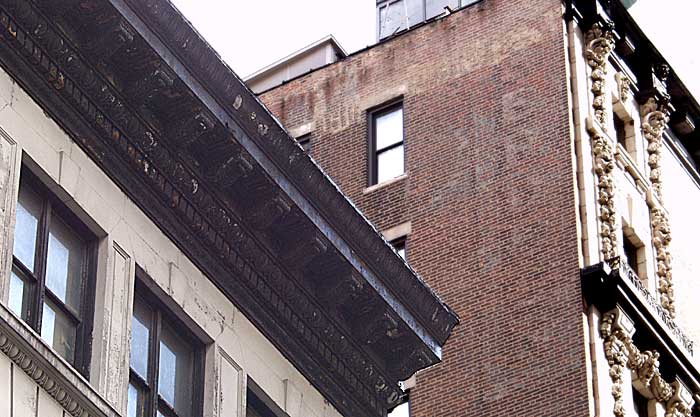
Hotel Aberdeen, 17 W. 32nd St. (2004)

Dimly visible the four letters "ERDE" running vertically down the west wall of the La Quinta Inn Manhattan (as of October 2004) are about all that remain of this sign for the Hotel Aberdeen. The sign was reaching the century mark as of the date of this photograph. The Hotel Aberdeen was built 1903-04. The Aberdeen was a 12-story mid-block hotel designed by the architect Harry B. Mulliken (1872-1952) of the firm Mulliken & Moeller as an apartment hotel.
The term apartment hotel refers to "a type of hybrid hotel developed in the 1870s and flourished between 1890 and 1910" (quoting New York 1900 by Robert A. M. Stern, Gregory Gilmartin and John Massengale, 1982). This was a type of hotel intended to provide hotel services to permanent residents rather than transients. Stern, et. al. says they were "initially intended for bachelors and young families as yet unable to afford a house or staff of their own." This type of residence, however, became popular with New York's middle class "until rapid rail transit made year-round, country-style suburban living accessible to city workers."
Mulliken & Moeller (Moeller was Edgar J. Moeller (1874-1954)) designed some-dozen additional apartment hotels in New York. One of the most prominent was the Lucerne, 201 W. 79th St. at Amsterdam Ave. The Lucerne (also 1904) combined a profusion of plum-colored terra cotta with a reddish brick exterior that is strikingly unique. For more on Mulliken & Moeller see Christopher Gray's "Streetscapes" article, New York Times, 14 Sept. 2003.
The Aberdeen Hotel itself is a landmarked building featuring its own profusion of terra cotta ornament. The sculptured entrance is noted by several architectural commentators for its "exuberance." Interestingly the AIA Guide to New York City (Norval White & Elliott Willensky, 4th ed., 2000), although featuring a photograph of the doorway and comparing its architectural style to ornate Parisian boulevard facades of the 1890s, did not credit its architect and dated the building to the 1890s. This was corrected in the 5th edition, 2010, where the dates are 1902-1904, and the architect is Harry B. Mulliken.
But the era of the apartment hotel passed quickly for the Aberdeen: "In 1912, the hotelís suites were subdivided and it began to accept transient guests; during the 1920s, the Aberdeen became one of the first hotels in the city to admit women travelers unaccompanied by men without subjecting them to strict rules" (quoting New York City Landmarks Commission).
The Hotel Aberdeen was listed in Rider's New York City: A Guide-Book for Travelers, compiled and edited by Fremont Rider, 1916, as, "Aberdeen, 17 W. 32d st. Small, catering to the traveler of moderate means, especially women traveling alone." The rates were $2.00 single room with bath, $4 suites.
Built To Last: 100+ Year-Old Hotels in New York by Stanley Turkel (2011) adds, "The Aberdeen Hotel was built in 1902-04 as an apartment hotel to the designs of architect Harry B. Mulliken for the Old Colony Company, a real estate development firm... The trade magazine, New York Hotel Record reported in April 1903 that the Old Colony Company had secured financing for its Aberdeen hotel project from the Alliance Realty Company and the Metropolitan Life Insurance Company for $207,130 and $400,000 respectively. Construction of the hotel began on May 3, 1903. The 154-room hotel was completed on September 15, 1904. In 1912, the Aberdeen's suites were subdivided and it began to accept transient guests. In the 1920's the Aberdeen became the first of a growing number of transient hotels to admit women travelers unaccompanied by men without subjecting them to strict rules... Since 1978, the hotel has been owned and operated by the Apple Core chain and its affiliates. Apple Core licensed the Best Western name in 1995 and has operated it as the La Quinta Manhattan since 2002."
The La Quinta Manhattan website may be visited at http://www.lq.com. The hotel now (2013) features 182 rooms.
Click for Aberdeen ads: 1904 1926
< previous || next > index map signs by date signs by name see what's new